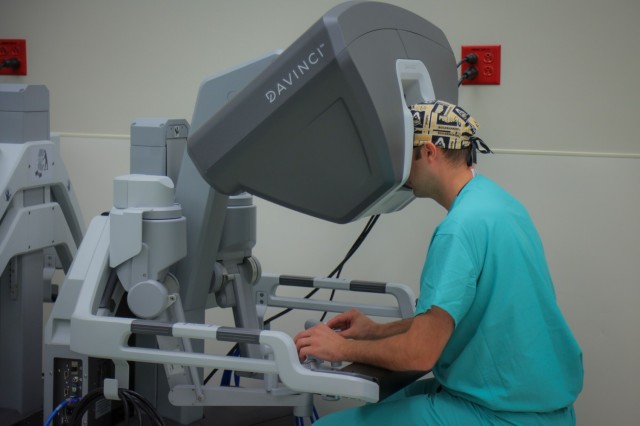Robotically-assisted surgery may sound like something from a futuristic science fiction movie to some, but it is actually a safe and increasingly common method shown to deliver better outcomes for patients than traditional surgery.
“It used to be a rare thing for [healthcare] institutions to have. They’d be at really big medical centers, but now, the technology is getting out into the rest of the medical community,” said Maj. (Dr.) Morgan Barron, a general surgeon at Blanchfield Army Community Hospital, who has been a driving force to bring this capability to BACH.
Barron started performing robotically-assisted surgery more than 10 years ago during his general surgery residency training at Madigan Army Medical Center, Joint Base Lewis-McChord, Washington. Additionally, the Institute for Defense Robotic Surgical Education, established at Keesler Air Force Base in 2017, has trained more than 100 surgeons and another 200 nurses and operating room technicians for the Department of Defense and Veterans Affairs in team-based skills in robotic surgery.
“It has a lot of broad applications, so we’re really excited to have this here. Being a general surgeon, this is something that I’ve been using for many years at other Personnel/staff treatment facilities and it is just fantastic.”
Robotically-assisted surgery is used for minimally invasive procedures. Unlike “open surgery” which involves cutting open skin and tissues to give the surgeon a full view of the structures or organs involved, “minimally invasive surgery” is a common technique requiring just three small incisions in most cases. One incision is for a small wand-like video camera that when inserted provides a magnified view of what’s going on inside the patient at the surgical site. This transmits a two-dimensional image which the surgeon views on a high definition monitor over the operating table. The other two incisions are used to insert the thin hand-held cutting tools, about the size of knitting needles, which the surgeon manipulates by hand to perform the operation.
“The typical minimally invasive surgery uses laparoscopic instruments that we call straight sticks. You stick them in and this is pretty much all you can do with them,” said Barron, turning his wrists left and right to demonstrate the limits of his range of motion. “With a robot you have full mobility of the robotic arms that we can use.”
Robotically assisted surgery provides surgeons better visualization and greater mobility. The robotically held instruments offer more precision and stability than traditional laparoscopy, explained Barron, and are not prone to the fatigue that a human may experience standing at an operating room table for a long period of time.
The robotically-assisted surgical system is made up of three components. The robotic cart has a unit with four “arms” which hold the camera and surgical instruments. The surgeon console is where the surgeon sits in an ergonomically designed control console directing the robotic arms movements. And the third component is a cart-like endoscopic stack that contains supporting hardware and software components, such as suction pumps and an electrosurgical unit.
“Once we put the robot in place next to the patient, we do all the controlling of the robot from a separate machine right there near the patient in the operating room. The console has 3-D vision technology. So as opposed to just looking at a standard monitor, like a TV screen, I can actually look in three dimensions. That really helps out my depth perception, and the controls really facilitate that wristed motion of the instruments,” Barron said.
The robotic system enables Barron to perform a wider range of procedures laparoscopically and among the benefits for patients are smaller incisions, less post-operative pain, shorter hospital stays and faster recovery times.
One example from his caseload Barron shared is hernia repair. A hernia is a condition, sometimes caused by muscle strain, heavy lifting, pregnancy and even strenuous coughing, and may require surgery to repair.
“For some abdominal hernia repairs, I would have to do a big open procedure which requires a long hospital stay, lots of pain medication, and a longer recovery time. Now patients may have the same operation done minimally invasively and have a very short recovery time. Most of my patients go home the same day,” he said.
Barron said that he wants patients to know robotically-assisted surgery is very safe and common.
“It is something that I propose to all my patients for certain procedures, but ultimately the choice is theirs,” said Barron, who tells his patients about all options during their initial consultations. “I’ve been using a robot at different institutions up to this point and my patients have had a lot of positive feedback. It can eliminate hours and hours in the operating room and provides superior results.”
Barron anticipates offering the option for robotically-assisted surgery at BACH very soon as the hospital awaits the final supporting components to bring the system fully online.
“This is considered kind of cutting edge surgical technology. This is something that is widely used, widely adopted, and is becoming increasingly a necessary tool to perform certain operations,” said Barron. “We are very happy to be able to offer this technology here.”

